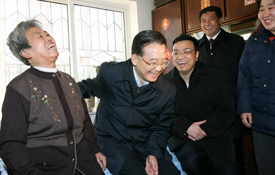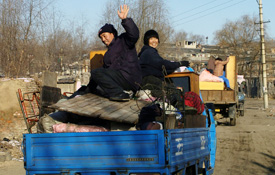|
 |
 |
|
HEARTY LAUGHTS: Chinese Premier Wen Jiabao (second left) and Li Keqiang (second right), then Liaoning Party Secretary, talk with Fei Guirong (left), a former shantytown resident who just moved into a new apartment in Fushun on February 16, 2007 (LIU WEIBING) |
SAYING GOODBYE: Residents of the shanty Qingcaogou Community in Fushun move out to new homes on November 30, 2006 (FEI QIANG) |
Guo Yonghai finally realized his dream of better living conditions when his family moved into a 45-square-meter apartment at the new Modi Community in Fushun, northeast China's Liaoning Province. "We had lived in an old 25-square-meter shanty. Thanks to the government policy, we were granted a new apartment for only 12,000 yuan ($1,904.76)," Guo said.
From 2005 to 2011, a total of 706,000 families like Guo's have moved out of shantytowns in Liaoning Province, according to the provincial Housing and Urban-Rural Construction Department.
Figures from the department show that by the end of 2011, 29.1 million square meters of shantytowns had been renovated and 44.02 million square meters of new apartments had been built, improving living conditions for 2.11 million residents.
"The task of renovating the province's concentrated shantytowns has been basically accomplished," said Department Director Wang Zhenggang, adding that more than 90 percent of the renovation project has been completed in the cities of the province.
A great achievement
Liaoning Province had the largest area of China's concentrated shantytowns. In order to improve the living conditions of residents, an ambitious project of renovating shantytowns was launched by the provincial government in 2005 and approved by the State Council, China's cabinet.
Liaoning was a national industrial base during the early 20th century and for a fairly long period after the founding of the People's Republic of China in 1949. It was home to major coal mines and heavy industries vital for the country's economy and development.
During Japan's colonization of northeast China before and during the War of Resistance Against Japanese Aggression (1937-45), when large amounts of mineral resources were transported to Japan, and the New China's exploitation, when coal and other minerals from Liaoning fueled factories all over China free of charge, large areas of makeshift work sheds were built for miners and became homes to their offspring in the following decades.
In the past couple of decades, with the eastern coastal provinces driving the country's development, Liaoning has been left far behind. Compounding this problem is the large number of laid-off workers, who lost their jobs as the country launched a large-scale reform of state-owned enterprises (SOEs). This made the living conditions in the shantytowns even worse.
Bone-chilling winters without heat, corroded walls and roofs that threaten to cave in at any moment were all waking nightmares for shantytown residents, some of whom even have been injured by falling bricks.
In the old Modi shantytown in Fushun, the list of woes used to read almost like a horror story—no tap water, no heating, no paved roads, no clean toilets and no primary school. In fact, its only primary school closed down in the mid-1980s because nobody wanted to send their children there.
Fushun was a major coal base from the 1950s to the 1980s and employed about 20,000 workers at its peak. But even then, local SOEs didn't provide enough houses for the workers before the 1990s because the motto then was "production overrides the principle of leisure." In the early 1990s, most of the mines went bankrupt because coal deposits had been depleted.
The laid-off workers began settling in large groups on the outskirts of the city in the last decade. Since these settlements were not planned, they lacked even the basic amenities. The result was that conditions worsened as the surrounding areas developed, and came to be called "villages in the city."
Fushun government figures show that its shantytowns were spread over 3.18 million square meters where 320,000 people, or one fifth of its population, lived before the massive reconstruction of shantytowns.
| 